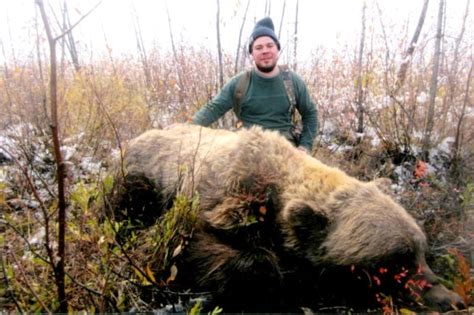
A massive grizzly bear harvested in Alaska has been officially recognized as a world record by the Boone and Crockett Club, scoring 27 and 6/16 inches. This makes it the largest grizzly bear skull ever recorded, surpassing the previous record holder.
The bear, taken in the fall of 2018 in the Game Management Unit 22 along the northwestern coast of Alaska, remained unsubmitted for official scoring for several years. Its immense size came to light when a Boone and Crockett measurer, after persistent encouragement, finally convinced the hunter to bring the skull in for evaluation.
“The skull was just enormous,” said Boone and Crockett Club’s Director of Big Game Records, Justin Spring. “It was immediately apparent that we were dealing with an exceptional specimen.”
The official scoring, conducted recently, confirmed the bear’s place in history. The Boone and Crockett Club, the oldest wildlife conservation organization in North America, maintains detailed records of North American big game trophies, using specific measurements to assess the size and maturity of animals. These records serve not only as a historical database but also as an indicator of successful wildlife management practices.
The final score of 27 and 6/16 inches is derived from adding the skull’s length and width measurements. This bear surpassed the previous record, taken in 1976 in Alaska’s Etolin Island, which scored 27 and 3/16 inches.
While the hunter’s name has not been released to protect their privacy, the Boone and Crockett Club acknowledged the significance of the harvest. The club emphasized that such a large bear is a testament to the healthy grizzly bear populations in Alaska and the effectiveness of the state’s wildlife management programs.
The circumstances surrounding the hunt remain largely undisclosed, but the focus has been on the bear’s exceptional size and its implications for conservation. The Boone and Crockett Club uses its scoring system to track trends in big game populations, with larger scores often indicating older, more mature animals thriving in a well-managed environment.
This record-breaking grizzly serves as a symbol of successful wildlife conservation in Alaska, showcasing the potential for large predators to thrive when given adequate habitat and protection. The Boone and Crockett Club’s records provide valuable data for wildlife managers, helping them to make informed decisions about hunting regulations and habitat management. The organization’s scoring system measures the outside dimensions of the skull, reflecting the animal’s overall size and maturity.
The discovery of this record-breaking bear has generated excitement within the hunting and conservation communities. It highlights the importance of ethical hunting practices and the role that hunters play in wildlife conservation. By responsibly harvesting animals and reporting their trophies, hunters contribute valuable data that helps to monitor and manage wildlife populations.
The Boone and Crockett Club’s records are used by researchers, wildlife managers, and conservationists to track trends in big game populations and assess the effectiveness of conservation efforts. The club’s scoring system provides a standardized method for measuring the size and maturity of animals, allowing for comparisons across different regions and time periods.
This record-breaking grizzly bear skull will be displayed at the Boone and Crockett Club’s headquarters in Missoula, Montana, where it will serve as a reminder of the importance of wildlife conservation and the potential for large predators to thrive in well-managed ecosystems. It stands as a testament to Alaska’s rich wildlife heritage and the dedication of those who work to protect it.
The story of this giant grizzly bear is not just about a record-breaking trophy; it’s about the success of conservation efforts and the health of Alaska’s grizzly bear population. It underscores the importance of sustainable hunting practices and the role that hunters play in contributing to wildlife management.
The Boone and Crockett Club’s commitment to ethical hunting and conservation is evident in its rigorous scoring system and its dedication to maintaining accurate records of North American big game trophies. The club’s efforts help to ensure that future generations will have the opportunity to experience the wonder of wild places and the abundance of wildlife.
Detailed Analysis and Expanded Context
The significance of this record-breaking grizzly bear extends beyond its sheer size. It offers a valuable insight into the health and management of grizzly bear populations in Alaska, one of the last strongholds for these magnificent creatures in North America. Grizzly bears, also known as brown bears (Ursus arctos horribilis), are an iconic symbol of the American wilderness, and their conservation is a matter of both ecological and cultural importance.
Grizzly Bear Conservation in Alaska
Alaska is home to a significant portion of the North American grizzly bear population. The state’s vast wilderness areas, abundant food sources, and effective wildlife management practices have allowed grizzly bears to thrive in many regions. The Alaska Department of Fish and Game (ADF&G) plays a crucial role in managing grizzly bear populations, using scientific data to set hunting regulations and implement habitat conservation measures.
The ADF&G conducts extensive research on grizzly bear populations, including population surveys, habitat assessments, and studies of bear behavior and ecology. This research informs the development of management plans that aim to maintain healthy bear populations while minimizing conflicts with humans.
Hunting is an important tool for managing grizzly bear populations in Alaska. Regulated hunting helps to control bear numbers in areas where they may be causing conflicts with humans or impacting other wildlife populations. Hunting also provides economic benefits to local communities and supports the state’s wildlife management programs through the sale of hunting licenses and tags.
The Boone and Crockett Club’s scoring system plays a role in grizzly bear management by providing data on the size and maturity of harvested bears. Larger scores often indicate older, more mature animals, which can be a sign of a healthy and stable population. The club’s records can also be used to track changes in bear size and distribution over time, providing valuable information for wildlife managers.
The Importance of Habitat
Habitat conservation is essential for the long-term survival of grizzly bears. These animals require large areas of undisturbed habitat to roam, forage, and reproduce. Protecting grizzly bear habitat involves preserving forests, wetlands, and other natural areas, as well as managing human activities such as logging, mining, and development to minimize their impact on bear populations.
Alaska has implemented a number of measures to protect grizzly bear habitat, including establishing protected areas such as national parks and wildlife refuges, and implementing regulations to control development in sensitive areas. The state also works with private landowners to promote responsible land management practices that benefit grizzly bears and other wildlife.
Human-Bear Conflicts
One of the biggest challenges in grizzly bear management is minimizing conflicts between humans and bears. As human populations grow and expand into bear habitat, the potential for conflicts increases. These conflicts can range from bears raiding garbage cans and damaging property to more serious incidents involving bear attacks.
The ADF&G works to reduce human-bear conflicts through education and outreach programs, as well as by implementing measures to manage bear behavior. These measures include relocating problem bears, providing bear-resistant garbage cans, and educating people about how to avoid attracting bears to their homes and communities.
Ethical Hunting and Conservation
The story of the record-breaking grizzly bear highlights the importance of ethical hunting practices and the role that hunters play in wildlife conservation. Ethical hunters respect the animals they hunt and follow all hunting regulations. They also contribute to wildlife conservation by purchasing hunting licenses and tags, which provide funding for wildlife management programs.
The Boone and Crockett Club promotes ethical hunting and conservation through its fair chase principles, which emphasize the importance of respecting the animal and giving it a fair chance to escape. The club also encourages hunters to report their trophies and contribute data to its records, which helps to monitor and manage wildlife populations.
The Boone and Crockett Club: A Legacy of Conservation
Founded in 1887 by Theodore Roosevelt and a group of like-minded conservationists, the Boone and Crockett Club has played a leading role in wildlife conservation in North America for over a century. The club’s mission is to promote the conservation and management of wildlife and wild places, and to ensure that future generations will have the opportunity to experience the wonder of the outdoors.
The Boone and Crockett Club has been instrumental in establishing many of the national parks and wildlife refuges in the United States, as well as in promoting sustainable hunting practices and wildlife management policies. The club’s records of North American big game trophies are a valuable resource for wildlife managers, researchers, and conservationists.
The club’s scoring system, which is used to measure the size and maturity of big game animals, provides a standardized method for tracking trends in wildlife populations. The club’s records also serve as a historical record of the animals that have been harvested in North America, providing a valuable insight into the past and present state of wildlife populations.
The Future of Grizzly Bears in Alaska
The future of grizzly bears in Alaska depends on continued efforts to conserve their habitat, manage their populations, and minimize conflicts with humans. The ADF&G will continue to play a crucial role in these efforts, working with other government agencies, private landowners, and conservation organizations to ensure that grizzly bears continue to thrive in Alaska for generations to come.
The Boone and Crockett Club will also continue to play a role in grizzly bear conservation by promoting ethical hunting practices, maintaining accurate records of big game trophies, and advocating for sound wildlife management policies. The club’s commitment to conservation and its dedication to preserving the legacy of Theodore Roosevelt will help to ensure that grizzly bears remain a symbol of the American wilderness for years to come.
The record-breaking grizzly bear harvested in Alaska is a reminder of the importance of wildlife conservation and the potential for large predators to thrive in well-managed ecosystems. It is a testament to Alaska’s rich wildlife heritage and the dedication of those who work to protect it. The story of this bear will continue to inspire future generations to appreciate and conserve the natural world.
FAQ: Alaskan Grizzly Bear Record
1. What makes this grizzly bear a world record?
This grizzly bear skull has been officially recognized by the Boone and Crockett Club as the largest ever recorded. Its score of 27 and 6/16 inches, derived from adding the skull’s length and width measurements, surpasses all previous records.
2. Where and when was this record-breaking grizzly bear harvested?
The grizzly bear was harvested in the fall of 2018 in Game Management Unit 22 along the northwestern coast of Alaska.
3. Why did it take so long for the bear to be officially recognized?
The hunter did not initially submit the skull for official scoring. It was after persistent encouragement from a Boone and Crockett measurer that the skull was finally brought in for evaluation.
4. What is the Boone and Crockett Club, and what is its role in this record?
The Boone and Crockett Club is the oldest wildlife conservation organization in North America. It maintains detailed records of North American big game trophies, using a specific scoring system to assess the size and maturity of animals. The club’s official scoring confirmed this grizzly bear as the world record holder. They also promote ethical hunting and conservation efforts.
5. What does this record-breaking bear tell us about grizzly bear populations in Alaska?
The existence of such a large bear suggests that grizzly bear populations in Alaska are healthy and thriving, reflecting the effectiveness of the state’s wildlife management programs. The large size indicates the bear lived a long life and had access to ample resources.
6. Why is the hunter’s name being withheld?
The hunter’s name is being withheld to protect their privacy.
7. What is the significance of the Boone and Crockett score?
The Boone and Crockett score, calculated by adding the skull’s length and width, is a standardized measure of the animal’s size and maturity. Higher scores generally indicate older and larger animals, suggesting a healthy population and effective wildlife management. The score allows for comparison of trophies across different regions and time periods.
8. How does hunting contribute to wildlife management in Alaska?
Regulated hunting helps to control bear numbers in areas where they may be causing conflicts with humans or impacting other wildlife populations. Hunting also provides economic benefits to local communities and supports the state’s wildlife management programs through the sale of hunting licenses and tags. The data collected from harvested animals, including measurements for scoring, is valuable for monitoring population trends.
9. What is being done to minimize human-bear conflicts in Alaska?
The ADF&G works to reduce human-bear conflicts through education and outreach programs, as well as by implementing measures to manage bear behavior. These measures include relocating problem bears, providing bear-resistant garbage cans, and educating people about how to avoid attracting bears to their homes and communities.
10. Where will the record-breaking grizzly bear skull be displayed?
The record-breaking grizzly bear skull will be displayed at the Boone and Crockett Club’s headquarters in Missoula, Montana.
11. What were the dimensions of the previous record holder?
The previous record holder, taken in 1976 on Alaska’s Etolin Island, scored 27 and 3/16 inches.
12. How does the Boone and Crockett Club promote ethical hunting?
The Boone and Crockett Club promotes ethical hunting through its fair chase principles, which emphasize respecting the animal and giving it a fair chance to escape. The club also encourages hunters to report their trophies and contribute data to its records, which helps monitor and manage wildlife populations.
13. What are some of the challenges facing grizzly bear populations in Alaska?
Challenges include habitat loss due to development, potential conflicts with humans as populations expand, and the need for continued monitoring and management to ensure healthy and sustainable populations. Climate change also poses a threat by potentially altering food sources and habitats.
14. What role do national parks and wildlife refuges play in grizzly bear conservation?
National parks and wildlife refuges provide protected areas where grizzly bears can roam, forage, and reproduce without the disturbance of human activities. These areas are essential for maintaining healthy grizzly bear populations and preserving their habitat.
15. How can individuals contribute to grizzly bear conservation?
Individuals can contribute to grizzly bear conservation by supporting organizations that work to protect grizzly bear habitat, practicing responsible behavior in bear country (such as storing food properly and carrying bear spray), and advocating for sound wildlife management policies. Reporting any bear sightings or encounters to local wildlife authorities is also helpful.
16. What is the Alaska Department of Fish and Game’s role in managing grizzly bear populations?
The Alaska Department of Fish and Game (ADF&G) plays a crucial role in managing grizzly bear populations, using scientific data to set hunting regulations and implement habitat conservation measures. The ADF&G conducts extensive research on grizzly bear populations, including population surveys, habitat assessments, and studies of bear behavior and ecology.
17. How does climate change affect grizzly bear populations?
Climate change can affect grizzly bear populations by altering food sources and habitats. Changes in temperature and precipitation patterns can impact the availability of berries, salmon, and other important food sources. Habitat loss due to melting glaciers and thawing permafrost can also pose a threat.
18. What are the fair chase principles of the Boone and Crockett Club?
The fair chase principles emphasize respecting the animal and giving it a fair chance to escape. This includes avoiding hunting in unsporting conditions, such as when an animal is trapped or injured, and using ethical hunting methods. The principles promote responsible and respectful hunting practices.
19. How are the Boone and Crockett Club’s records used by researchers and wildlife managers?
The Boone and Crockett Club’s records are used by researchers and wildlife managers to track trends in big game populations and assess the effectiveness of conservation efforts. The club’s scoring system provides a standardized method for measuring the size and maturity of animals, allowing for comparisons across different regions and time periods. The data helps inform management decisions related to hunting regulations, habitat protection, and population control.
20. What is the long-term outlook for grizzly bear populations in Alaska?
The long-term outlook for grizzly bear populations in Alaska is generally positive, provided that continued efforts are made to conserve their habitat, manage their populations, and minimize conflicts with humans. Sustained funding for research and management, along with public support for conservation efforts, will be essential for ensuring that grizzly bears continue to thrive in Alaska for generations to come.









